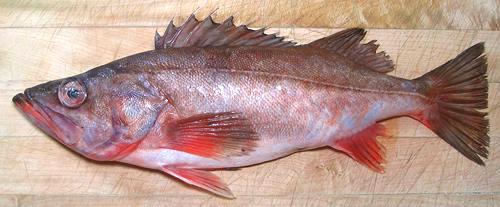 [Sebastes brevispinis]
[Sebastes brevispinis]
This rockfish is found from along the Aleutian Islands of Alaska down to the tip of Baja California, Mexico, but is not common south of the Canadian border. It can grow to 28 inches and a little over 10 pounds, but the photo specimen, purchased from a large Asian market in Los Angeles, was 14-3/4 inches and weighed 1 pound 3-1/4 ounces. This is considered a very fine eating fish IUCN Red Listed as NE (Not Evaluated). As with all rockfish, the catch is regulated in California and probably in the northern states as well. This fish is often tossed in with other rockfish of similar color, and this fish was mixed with Speckled Rockfish, both mislabeled as "Gother cod".
More on Rockfish.
Silvergray Rockfish flesh is tender, a bit darker than white, and has a very enjoyable flavor, light but not insipidly so. There is no strip or layer of darker flesh on this fish.
The flesh holds together well for most types of cooking. It holds together well enough for poaching, but will break up fairly quickly simmered in soup. The flakes are large so this may not be a problem. It is excellent poached or lightly powdered with rice flour and pan fried. Use only very light sauces so you can enjoy the flavor of the fish. this fish is not suitable for "whole fish" recipes because of skin shrink.
Buying: This fish can be found in in Asian markets in Los Angeles, and at a good price. I bought it from the "No cut no clean" bin for 2014 US $1.99 per pound. At the "full service" counter it would have been $2.99 per pound. In other markets it may be sold as fillets mixed with other rockfish (or even other fish), so you don't know what you're really getting.
Scales: Speckled Rockfish is covered with small scales that scrape off fairly easily and fly about only moderately.
Cleaning: There's nothing unusual in cleaning this fish. The gills are firmly attached, so cut them out with kitchen shears. Do be careful with the dorsal spines, they are exceedingly sharp.
Fillet: Speckled Rockfish is very easy to fillet with an easy to follow fin and bone structure, and the flesh holds together well. First cut off the head, turning the knife steeply under the gill covers to get the maximum amount of flesh. Outline the fillet by cutting through the skin along the top, across the tail and especially along the bottom. Cut from the top down following the bones to the backbone. Hop over the backbone at the tail and work forward. When you get to the ribcage just cut the ribs loose from the backbone with kitchen shears and pull them from the fillet with long nose pliers. They pull fairly easily and take little flesh. There are some substantial centerline spines for the length of the body cavity but they are easy to locate. Pull them straight forward and they will come out fairly easily. Method.
Yield: A 1 pound 3-1/4 ounce fish yielded 9-5/8 ounces skin-on fillets (50%) and 8-1/2 ounces skin-off (44%). Fillet weights include the skirt which is fleshy and quite usable (if your fish was fresh). There will still be some flesh around the pelvic (bottom) fins which can't be removed until after a short simmer.
Skin: Skin shrink is fairly strong and doesn't release from the flesh easily. The skin has no strong or "off" flavor. It is thin but quite strong, and it's adhesion is light, so it's very easy to remove by the standard long knife and cutting board Method. Almost no flesh should be lost. If you are making stock, the skins can be included.
Stock: The head, fins and bones and skins, simmered slowly for 40 minutes, make a light colored stock with little oil. What oil there is should be removed using your gravy separator. The stock is a little stronger flavored than some, but not unpleasantly so.
sf_rocksgz* 141106 - www.clovegarden.com